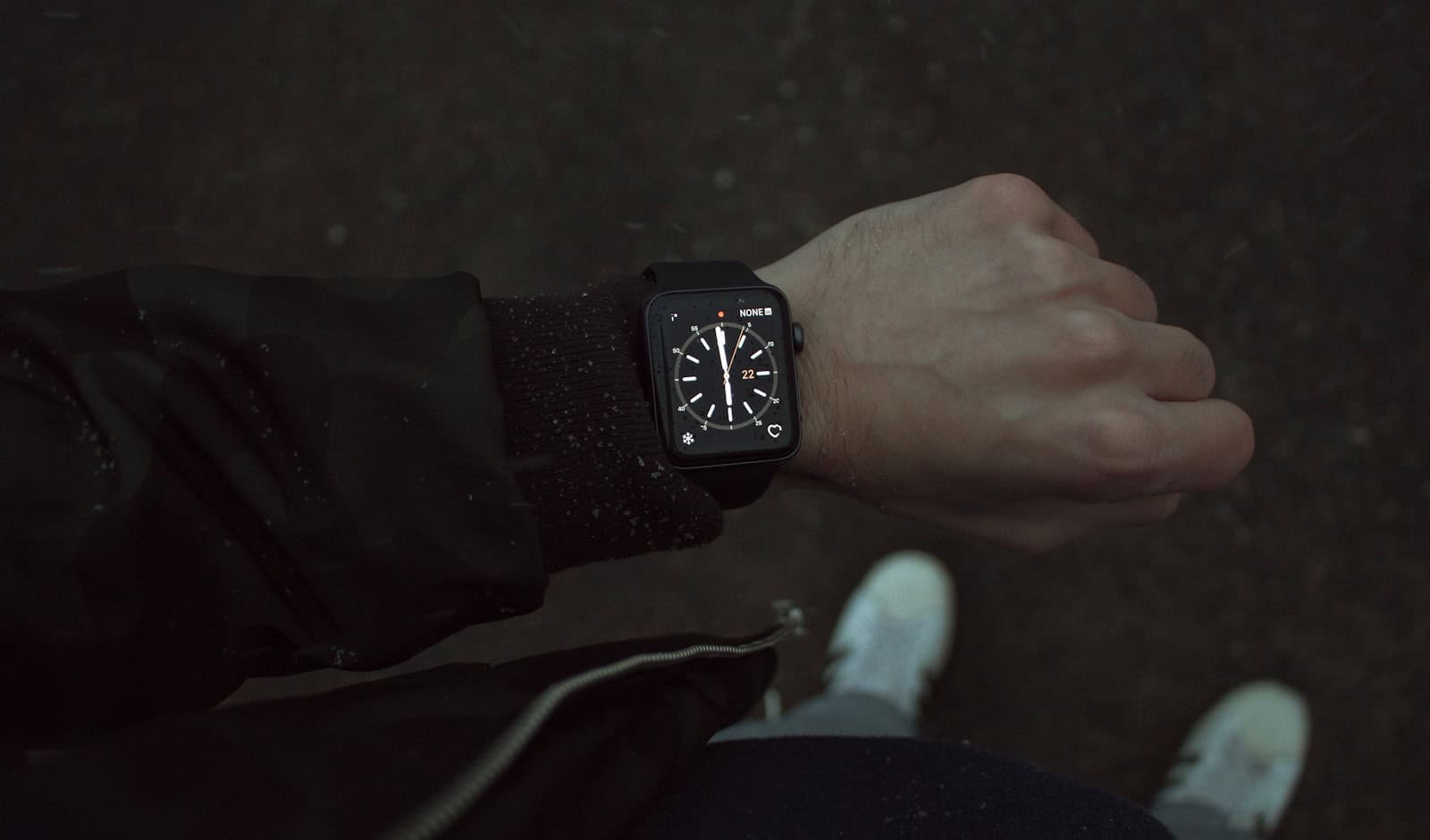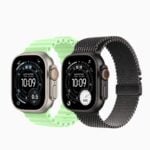Apple may be gearing up to transform the Apple Watch in ways we’ve only seen in sci-fi movies. Reports suggest that by 2027, future Apple Watch models could come equipped with built-in cameras—marking a huge leap in wearable tech innovation. From snapping photos on the go to unlocking new AI-powered experiences, the addition of cameras could push the Apple Watch far beyond its role as a fitness tracker or notification hub.
Cameras on Your Wrist: What Apple Is Planning
According to Bloomberg’s Mark Gurman, Apple is exploring adding cameras to both its standard Apple Watch series and the rugged Apple Watch Ultra. The company is reportedly testing two different placements: an under-display camera seamlessly integrated into the watch face, or a more conventional camera located near the Digital Crown on the side of the device.
This isn’t Apple’s first brush with the idea of cameras on the wrist. A 2019 patent outlined concepts for a watch band with a built-in camera, complete with the ability to rotate and capture images at different angles. While that design never hit the market, it showed Apple’s early interest in wrist-worn photography. Now, with advancements in miniaturized camera sensors and AI-driven image processing, the concept appears much closer to reality.
What Could a Camera Do on the Apple Watch?
This isn’t about selfies or casual snapshots—though those would be possible, too. Apple’s vision is far more ambitious. The camera would act as a gateway to a new feature called Visual Intelligence, part of the broader Apple Intelligence suite of AI tools expected to debut in upcoming devices.
Imagine pointing your watch at a flyer and automatically adding event details to your calendar. Or scanning a product on a store shelf and instantly pulling up reviews or price comparisons. Visual Intelligence aims to recognize objects, text, and environments, delivering useful, real-time information based on what the camera “sees.”
And yes, there’s a security benefit, too. A wrist-mounted camera could enable new forms of biometric authentication, including facial recognition, adding another layer of security to Apple’s wearable lineup.
Competing Visions: How Apple’s Plans Stack Up
Apple isn’t alone in this space. Meta’s Ray-Ban smart glasses and Snap’s Spectacles have already integrated cameras into wearable tech, focusing on photo and video capture for social sharing. However, Apple’s move seems more focused on practical, AI-enhanced utilities rather than just capturing memories.
In fact, Apple filed another patent in 2023 that hints at gesture control and augmented reality applications. A camera-equipped Apple Watch could serve as a controller for AR experiences, especially as Apple doubles down on its Vision Pro headset and spatial computing initiatives. Imagine using your watch as a lens or scanner in the Apple ecosystem’s broader AR environment.
The Road to 2027 and Beyond
While the target date for camera-equipped Apple Watches is reportedly around 2027, Apple’s strategy seems to align with its shift toward fully in-house AI development. By then, Apple plans to reduce reliance on third-party AI providers like OpenAI and Google, focusing instead on proprietary AI models optimized for on-device processing.
If successful, these upgrades could not only enhance privacy—since data processing happens locally on your device—but also unlock faster, more seamless AI interactions. And with Apple’s emphasis on health and fitness, future camera uses might include monitoring skin conditions or analyzing movement patterns for personalized workout feedback.
Is This the Next Big Thing for Wearables?
The Apple Watch has already redefined what a smartwatch can be, but cameras could be the next frontier. Whether it’s improving day-to-day convenience with Visual Intelligence, offering new ways to interact with AR, or simply snapping quick photos without pulling out your phone, the potential is massive.
As always with Apple, we won’t know the full story until they officially unveil the tech. But if the rumors hold true, the Apple Watch of the future could make today’s models look quaint by comparison.
Key Takeaways
- Apple is developing camera technology for both standard Apple Watch and Ultra models with potential release by 2027
- Camera placement options include under-screen integration or side-mounted positioning for different use cases
- This upgrade represents Apple’s continued innovation in wearable technology and may change how we capture everyday moments
Evolution of the Apple Watch
The Apple Watch has transformed from a simple notification device to a comprehensive health and fitness companion since its launch. Its journey showcases Apple’s commitment to innovation in wearable technology while maintaining a focus on user experience.
Incorporation of Health Features
When Apple first released the Apple Watch in 2015, it had basic fitness tracking capabilities. Over time, the device gained impressive health monitoring features. The Series 4 introduced the ECG (Electrocardiogram) function, allowing users to check their heart rhythm for irregularities.
Later models added blood oxygen monitoring, sleep tracking, and temperature sensing. Apple also improved the heart rate sensor accuracy with each generation. The watch now detects falls and can automatically call emergency services if needed.
Fitness tracking evolved from simple step counting to detailed workout analysis. The Apple Watch now tracks dozens of exercise types and provides personalized coaching.
Health data integration with the iPhone Health app creates a complete picture of the user’s wellbeing. This makes the watch valuable for both everyday health monitoring and managing specific medical conditions.
Design and User Interface Innovations
The Apple Watch’s physical design has evolved subtly but meaningfully. Early models had a square display with rounded corners, while newer versions offer larger screens with thinner bezels.
The Digital Crown, a key feature since the first model, received haptic feedback in later versions. This small wheel allows users to navigate the interface without covering the screen. Apple also added a side button that provides quick access to frequently used apps.
Display technology improved dramatically, moving from OLED to always-on Retina displays. This lets users glance at information without raising their wrist.
Material choices expanded beyond aluminum to include stainless steel, titanium, and ceramic options. Water resistance improved from splash-proof to swim-proof with 50m water resistance.
The user interface became more intuitive with each watchOS update. Apple introduced features like the Dock for app switching and customizable watch faces to match different needs and styles.
Potential of Camera Integration in the Apple Watch
Apple has been exploring ways to add cameras to the Apple Watch, as shown by several patents. This technology could transform how we use smartwatches for communication and daily tasks.
User Experience Enhancements
A camera on the Apple Watch could enable video calls directly from your wrist. This feature would eliminate the need to pull out your phone for quick chats with friends or family. Recent patents show Apple developing special strap release mechanisms that could work with built-in cameras.
The camera might also serve as a quick capture tool for moments that would otherwise be missed. Imagine seeing something interesting while your phone is tucked away in a bag or pocket. With a wrist tap, you could snap a photo instantly.
Apple might include these potential features with a watch camera:
- Quick photo and video capture
- FaceTime on your wrist
- Document scanning
- Fitness form checking
The camera placement could be above the display in a slight protrusion, according to patent filings. This design maintains the watch’s sleek look while adding new functionality.
Privacy and Security Considerations
A wrist-mounted camera raises important privacy questions. People might not notice being recorded by a watch as easily as they would a phone. Apple would likely need to add visual indicators when the camera is active.
Security benefits could include Face ID for the Apple Watch. This would add an extra layer of protection for sensitive information stored on the device. The patent applications suggest Apple is considering this feature.
Battery life remains a concern. Camera use typically drains power quickly, and the Apple Watch already has limited battery capacity. Apple would need to solve this challenge before bringing the feature to market.
Data protection will be critical too. Photos and videos captured on the watch would need secure storage and transfer methods to protect user privacy.
Implications of an Apple Watch With Cameras
Adding cameras to Apple Watches would transform how we use these devices, bringing new capabilities and raising important questions about privacy and design.
Emerging Use Cases
The integration of cameras into Apple Watches opens exciting possibilities beyond just taking photos.
AI-Enhanced Experiences could become a key feature. Cameras would allow the watch to “see” the world around you, providing context-aware information. For example, the watch might identify plants, landmarks, or even food items with visual AI.
Face ID functionality could eliminate the need for PINs on work profiles. This would make the watch more secure yet easier to use.
Health monitoring could improve too. Cameras might track subtle skin color changes to detect stress or analyze food portions for nutritional tracking.
Video calling from your wrist would become possible. This feature could be especially valuable for quick check-ins or emergency situations.
Challenges and Controversies
Privacy concerns top the list of potential problems. A wearable camera raises questions about surveillance capabilities and recording without consent.
Design limitations present significant hurdles. The small screen size of watches makes viewing photos difficult. Battery life would likely suffer with camera use, as cameras typically consume substantial power.
Apple must address the “spy watch” perception. Public backlash could occur if people fear being recorded secretly by smartwatch users.
Heat generation is another technical challenge. Cameras and their processing requirements generate heat, which is problematic in a device worn directly against skin.
Pricing impacts must be considered. Adding camera technology would likely increase costs, potentially putting Apple Watches out of reach for some consumers.
Apple’s Innovation Trajectory
Apple continues to push boundaries with its wearable technology. The company’s history of strategic innovations suggests cameras for Apple Watch are a natural next step in expanding functionality beyond health tracking and notifications.
Notable Predictions from Industry Experts
Ming-Chi Kuo, a respected Apple analyst, has previously hinted at camera integration in future Apple Watch models. His track record of accurate predictions gives weight to the possibility of this feature arriving soon.
Several Apple patents have emerged showing different approaches to adding cameras. One design shows a camera built into a slight protrusion above the display.
Another patent suggests a removable watch design where users can detach part of the watch to take photos. This addresses the awkward angle problem of wrist-mounted cameras.
Experts believe these cameras could enable:
- Face ID authentication
- Video calling directly from the watch
- Quick photo capture without reaching for a phone
Comparison With Competitor Technologies
Samsung already offers smartwatches with cameras, though these have seen limited success due to quality and usability issues. Apple’s approach appears more thoughtful, focusing on practical use cases rather than simply adding features.
Current competitor watches with cameras suffer from:
- Poor image quality
- Awkward positioning
- Limited storage
- Battery drain issues
Apple’s distinctive organizational model for innovation may help overcome these challenges. The company typically waits until technology can be implemented seamlessly before release.
Apple’s recent camera experiments with other wearables, like camera-equipped AirPods for AI vision features, show the company’s broader strategy. This suggests the Apple Watch camera would integrate with Apple Intelligence for enhanced functionality.
Design Considerations for Camera-equipped Apple Watches
Adding cameras to Apple Watches presents unique challenges for designers who must balance functionality with comfort and style. The placement and integration of camera components will significantly impact both the watch’s usability and its appeal as a wearable accessory.
Ergonomics and Accessibility
Camera placement on the Apple Watch requires careful thought about how users naturally hold and interact with their devices. A top-edge camera position would allow for more natural photo-taking but might require a slight case protrusion.
For Face ID functionality, the camera would need to face the user, which presents different design challenges. Users with limited wrist mobility might struggle with certain camera positions.
Button placement must not interfere with camera use. Designers need to consider how people will trigger the camera while maintaining a steady hand for clear photos.
Water and dust resistance ratings must be maintained despite adding new openings in the watch case. This might require special seals around camera components.
Band Integration Possibilities
Apple might explore removable watch designs where users can detach the watch face to take photos. This could solve many ergonomic issues but introduces new concerns about device security.
Some patents suggest camera integration directly into the watch band. This approach would allow for multiple camera positions without compromising the main watch body design.
A rotating camera ring mounted on the band could provide flexibility in shooting angles without needing to twist one’s wrist into uncomfortable positions. This would be particularly useful for video calls.
Smart bands with embedded cameras might become interchangeable accessories, allowing users to add or remove camera functionality as needed. This would make the technology optional rather than built-in.
Siri and Voice Commands
The integration of cameras in future Apple Watch models will likely enhance how users interact with Siri and control their devices through voice. Voice commands would play a crucial role in operating these new camera features hands-free.
Enhancing Interactivity Through Voice Control
Siri on the Apple Watch could get smarter with camera integration. Users might say commands like “Hey Siri, take a photo” or “Siri, scan this document” without touching the watch. This would be especially helpful during workouts or when hands are busy.
Apple believes Siri could become the “connective tissue” between their future products. With cameras on the Apple Watch, voice commands might expand to include photo editing instructions or quick sharing options.
The recent launch of Apple Intelligence shows the company is working on making Siri more natural and capable. This technology could power advanced camera controls on the watch.
Some Apple Watch Ultra models already allow users to set the Action button for tasks like opening the Translate app or starting voice memos. Camera functions might join these options.
Hand gestures combined with voice commands could create new ways to control the watch’s camera features, similar to what Apple might be planning for AR experiences.
Integration with the Apple Ecosystem
Adding cameras to the Apple Watch would create new possibilities for how the device works with other Apple products. The connection between the Watch and iPhone would become even more powerful with visual capabilities.
Seamless Connectivity With iPhone
The Apple Watch with cameras would likely connect to the iPhone in new ways. Photos and videos taken on the Watch could automatically sync to the Photos app on your iPhone. This would happen without any extra steps needed.
Users might be able to use their Watch as a remote camera for their iPhone. This could be helpful for taking group photos or videos from different angles.
The cameras could also improve video calls. You might answer FaceTime calls on your wrist and chat face-to-face without taking out your iPhone.
Apple’s ecosystem already lets devices work together smoothly. The Watch camera would fit into this system, sharing data with Health and Fitness apps on iPhone for advanced tracking features.
Security would be enhanced too. Watch cameras might enable Face ID features similar to those on iPhone, allowing for secure unlocking and app authentication.
Frequently Asked Questions
Adding cameras to Apple Watches raises several key questions about battery impact, new features, privacy concerns, and design challenges that consumers should consider before purchasing future models.
How will camera integration affect the battery life of the Apple Watch?
Camera functionality would likely increase power consumption on the Apple Watch. Photo and video recording require significant processing power.
Battery life might decrease by several hours when actively using camera features. Apple may need to increase battery capacity or improve efficiency in future models.
Current Apple Watches typically last 18 hours on a single charge. A camera-equipped model might need larger batteries or more power-efficient components to maintain similar battery performance.
What potential features could be enabled by adding a camera to the Apple Watch?
A camera could enable Face ID authentication, making it easier to unlock the watch without typing a PIN code.
Quick photo capture could become possible directly from the wrist. This would be useful for capturing moments when a phone isn’t readily available.
Video calling might become available, though some experts question whether FaceTime would be practical on such a small screen.
Health monitoring might improve with visual tracking capabilities. The camera could potentially monitor skin changes or other visual health markers.
Are there privacy concerns regarding the use of cameras in wearable technology like the Apple Watch?
Privacy risks increase with wearable cameras since they’re less noticeable than phone cameras. People may not realize they’re being recorded.
Public spaces might need new rules about wearable camera use. Schools, gyms, and other sensitive locations may restrict watch cameras.
Data security becomes more complex with visual information storage. Apple would need strong encryption for photos and videos captured on the device.
What differences in functionality can be expected between wearable rings and smart glasses compared to an Apple Watch with a camera?
Smart glasses offer hands-free recording from eye level, while an Apple Watch camera would require arm positioning. This creates different use cases for each device.
Wearable rings focus on control rather than image capture. They complement rather than compete with camera-equipped watches.
Watch cameras would likely offer better image quality than smaller wearables. The larger form factor allows for better optical components.
How might Apple address image stabilization in a camera-equipped Apple Watch?
Apple may implement digital stabilization algorithms to counter hand movement. This would help reduce blur in photos and shakiness in videos.
Physical design might include a slight protrusion above the display to house the camera. This would help with lens quality and stability.
Software corrections could automatically adjust for common wrist angles. This would make taking photos more intuitive without awkward positioning.
What are the projected release dates for any new Apple Watch models featuring cameras?
Bloomberg reports Apple is working on multiple watch models with cameras for release by 2027. This suggests we’re still a few years away from seeing this technology.
Patent applications show Apple has been researching adding cameras to Apple Watches for several years. These patents indicate serious development but don’t guarantee product releases.
No official announcements have been made about camera-equipped watches. Apple typically doesn’t confirm product features until formal product launches.







